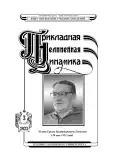Spatial and temporal dynamics of the emergence of epidemics in the hybrid SIRS+V model of cellular automata
- Authors: Shabunin A.V.1
-
Affiliations:
- Saratov State University
- Issue: Vol 31, No 3 (2023)
- Pages: 271-285
- Section: Articles
- URL: https://journals.rcsi.science/0869-6632/article/view/250955
- DOI: https://doi.org/10.18500/0869-6632-003042
- EDN: https://elibrary.ru/PBXBCY
- ID: 250955
Cite item
Full Text
Abstract
Keywords
About the authors
Aleksej Vladimirovich Shabunin
Saratov State Universityul. Astrakhanskaya, 83, Saratov, 410012, Russia
References
- Бейли Н. Математика в биологии и медицине. М.: Мир, 1970. 326 с.
- Марчук Г. И. Математические модели в иммунологии: Вычислительные методы и эксперименты. М.: Наука, 1991. 276 c.
- Hethcote H. W. The mathematics of infectious diseases // SIAM Review. 2000. Vol. 42, no. 4. P. 599–653. doi: 10.1137/S0036144500371907.
- Андерсон Р., Мэй Р. Инфекционные болезни человека: Динамика и контроль. М.: Мир, 2004. 784 c.
- Serfling R. E. Methods for current statistical analysis of excess pneumonia-influenza deaths // Public Health Reports. 1963. Vol. 78, no. 6. P. 494–506. doi: 10.2307/4591848.
- Burkom H. S., Murphy S. P., Shmueli G. Automated time series forecasting for biosurveillance // Statistics in Medicine. 2007. Vol. 26, no. 22. P. 4202–4218. doi: 10.1002/sim.2835.
- Pelat C., Boelle P.-Y., Cowling B. J., Carrat F., Flahault A., Ansart S., Valleron A.-J. Online detection and quantification of epidemics // BMC Medical Informatics and Decision Making. 2007. Vol. 7. P. 29. doi: 10.1186/1472-6947-7-29.
- Kermack W. O., McKendrick A. G. A contribution to the mathematical theory of epidemics // Proc. R. Soc. Lond. A. 1927. Vol. 115, no. 772. P. 700–721. doi: 10.1098/rspa.1927.0118.
- Bailey N. T. J. The Mathematical Theory of Infectious Diseases and Its Applications. 2nd edition. London: Griffin, 1975. 413 p.
- Boccara N., Cheong K. Automata network SIR models for the spread of infectious diseases in populations of moving individuals // Journal of Physics A: Mathematical and General. 1992. Vol. 25, no. 9. P. 2447–2461. doi: 10.1088/0305-4470/25/9/018.
- Sirakoulis G. C., Karafyllidis I., Thanailakis A. A cellular automaton model for the effects of population movement and vaccination on epidemic propagation // Ecological Modelling. 2000. Vol. 133, no. 3. P. 209–223. doi: 10.1016/S0304-3800(00)00294-5.
- Шабунин А. В. SIRS-модель распространения инфекций с динамическим регулированием численности популяции: Исследование методом вероятностных клеточных автоматов // Известия вузов. ПНД. 2019. T. 27, № 2. C. 5–20. doi: 10.18500/0869-6632-2019-27-2-5-20.
- Шабунин А. В. Синхронизация процессов распространения инфекций во взаимодействующих популяциях: Моделирование решетками клеточных автоматов // Известия вузов. ПНД. 2020. T. 28, № 4. С. 383–396. doi: 10.18500/0869-6632-2020-28-4-383-396.
- Hamer W. H. Epidemic disease in England – the evidence of variability and persistence of type // The Lancet. 1906. Vol. 1. P. 733–739.
- Gopalsamy K. Stability and Oscillations in Delay Differential Equations of Population Dynamics. Dordrecht: Springer, 1992. 502 p. doi: 10.1007/978-94-015-7920-9.
- Пеpеваpюxа А.Ю. Непрерывная модель трех сценариев инфекционного процесса при факторах запаздывания иммунного ответа // Биофизика. 2021. Т. 66, № 2. С. 384–407. doi: 10.31857/S0006302921020204.
- Переварюха А.Ю. Модель адаптационного противодействия индуцированной биотической среды в инвазионном процессе // Известия вузов. ПНД. 2022. T. 30, № 4. С. 436–455. doi: 10.18500/0869-6632-2022-30-4-436-455.
- Шабунин А. В. Гибридная SIRS-модель распространения инфекций // Известия вузов. ПНД. 2022. T. 30, № 6. С. 717–731. doi: 10.18500/0869-6632-003014.
- Кобринский Н. Е., Трахтенберг Б. А. Введение в теорию конечных автоматов. М: Физматгиз, 1962. 405 с.
- Тоффоли Т., Марголус Н. Машины клеточных автоматов. М.: Мир, 1991. 283 с.
- Ванаг В. К. Исследование пространственно распределенных динамических систем методами вероятностного клеточного автомата // УФН. 1999. Т. 169, № 5. С. 481–505. DOI: 10.3367/ UFNr.0169.199905a.0481.
- Provata A., Nicolis G., Baras F. Oscillatory dynamics in low-dimensional supports: A lattice Lotka–Volterra model // J. Chem. Phys. 1999. Vol. 110, no. 17. P. 8361–8368. DOI: 10.1063/ 1.478746.
- Shabunin A. V., Baras F., Provata A. Oscillatory reactive dynamics on surfaces: A lattice limit cycle model // Phys. Rev. E. 2002. Vol. 66, no. 3. P. 036219. doi: 10.1103/PhysRevE.66.036219.
- Tsekouras G., Provata A., Baras F. Waves and their interactions in the lattice Lotka–Volterra mode // Известия вузов. ПНД. 2003. Т. 11, № 2. С. 63–71.
- Boccara N., Cheong K. Critical behaviour of a probabilistic automata network SIS model for the spread of an infectious disease in a population of moving individuals // Journal of Physics A: Mathematical and General. 1993. Vol. 26, no. 15. P. 3707–3717. doi: 10.1088/0305- 4470/26/15/020.
- Benyoussef A., HafidAllah N. E., ElKenz A., Ez-Zahraouy H., Loulidi M. Dynamics of HIV infection on 2D cellular automata // Physica A. 2003. Vol. 322. P. 506–520. doi: 10.1016/S0378- 4371(02)01915-5.
- Fujisaka H., Yamada T. Stability theory of synchronized motion in coupled-oscillator systems // Progress of Theoretical Physics. 1983. Vol. 69, no. 1. P. 32–47. doi: 10.1143/PTP.69.32.
- Yamada T., Fujisaka H. Stability theory of synchronized motion in coupled-oscillator systems. II: The mapping approach // Progress of Theoretical Physics. 1983. Vol. 70, no. 5. P. 1240–1248. doi: 10.1143/PTP.70.1240.
Supplementary files










